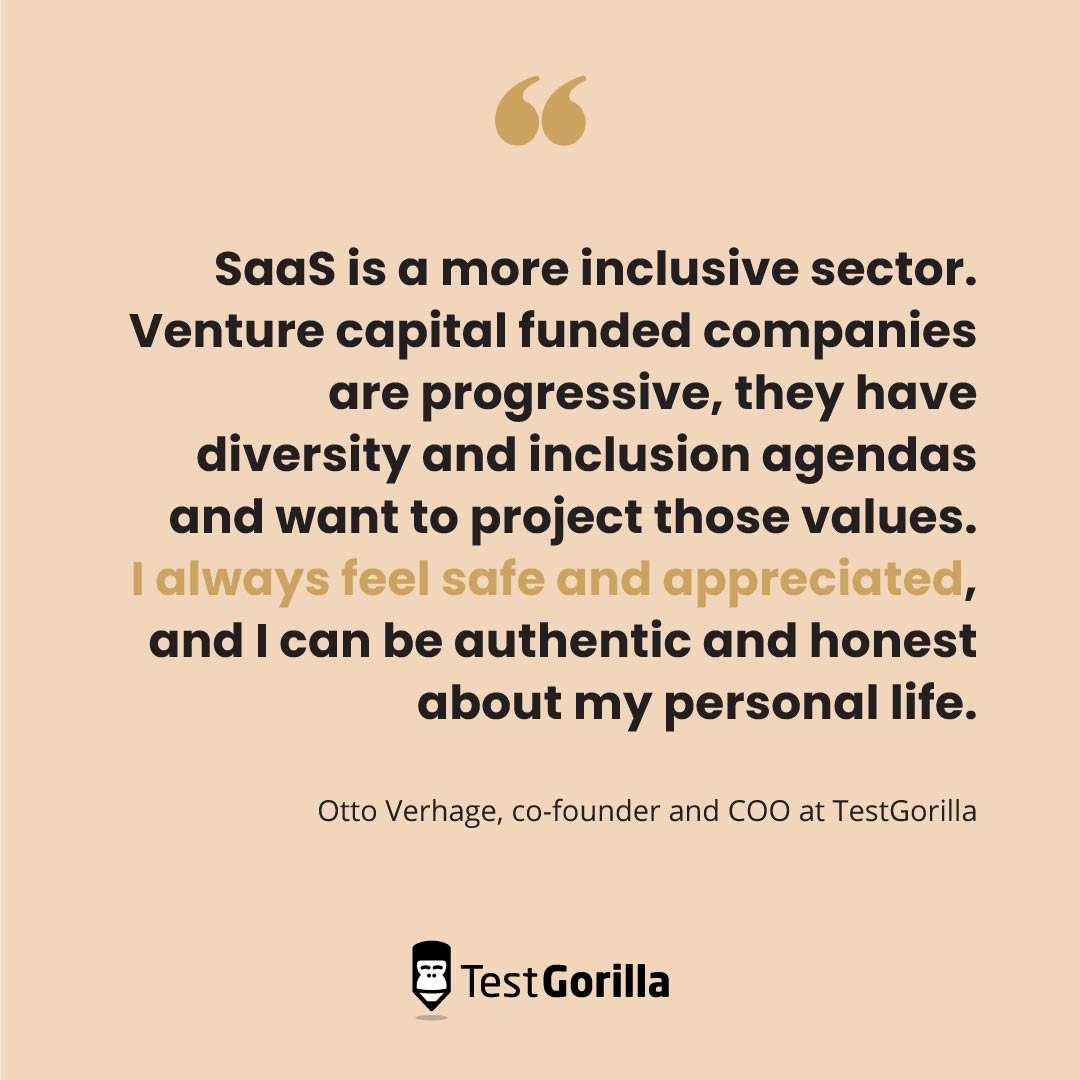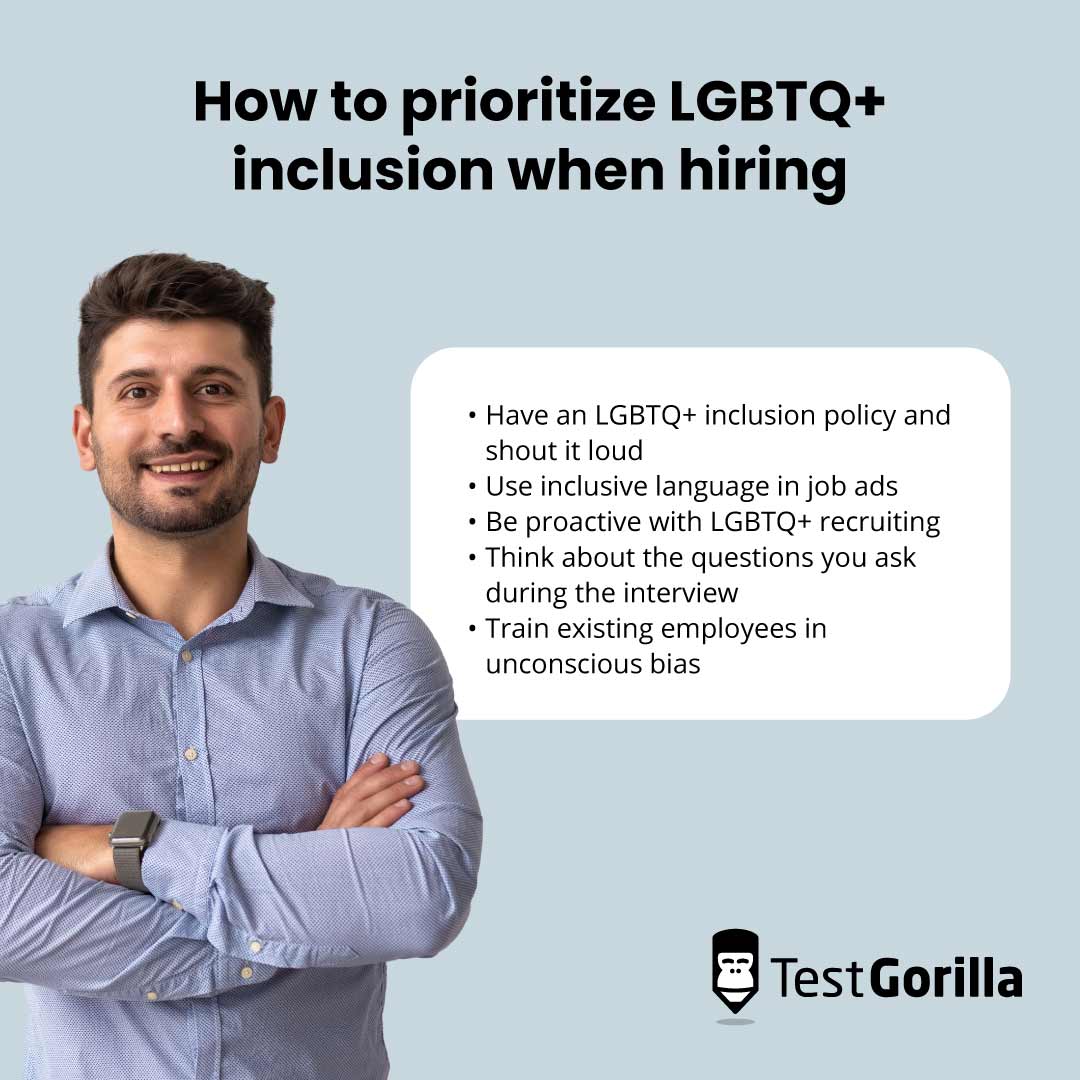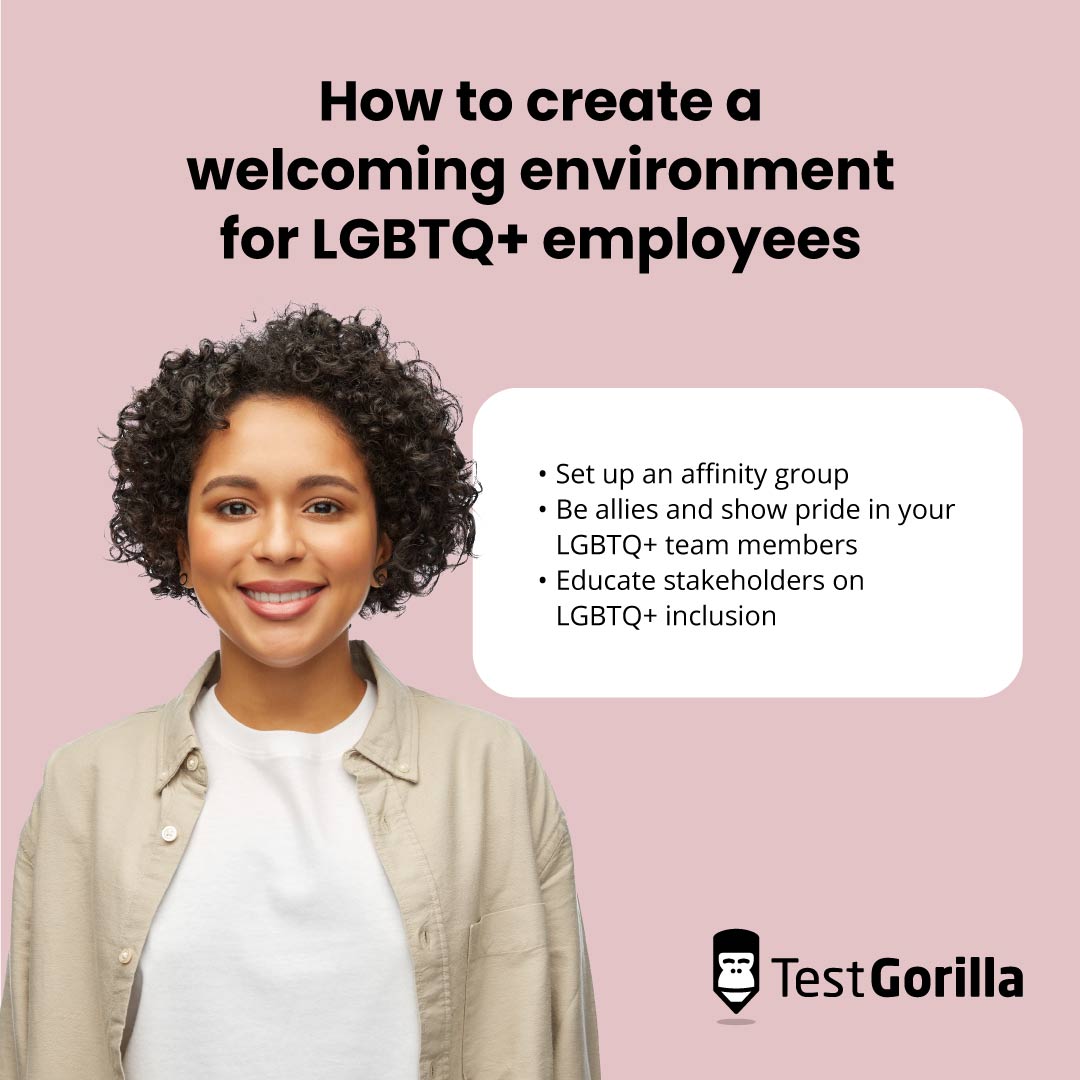LGBTQ+ inclusion in the workplace: Can everyone be out, loud, and proud?
It might seem like the battle for LGBTQ+ rights has been fought and won, and people from every part of the LGBTQ+ community can be out, loud, and proud at work. But despite labor laws protecting LGBTQ+ rights in North America and across the EU, the day-to-day experience at work can involve prejudice, bullying, and a lack of opportunity.[1]
In fact, recent research suggests masculine-presenting gay men are more likely to get leadership roles, leading some gay men to consciously or unconsciously suppress feminine traits.[2]
In this piece, we’ll look at different LGBTQ+ experiences in the workplace and some policies and best practices that you can adopt to foster a more inclusive and diverse company culture.
Table of contents
A battle fought and won? LGBTQ+ rights in 2023
In a recent survey, over 40% of LGBTQ+ workers in the US reported experiencing unfair treatment at work, including not being hired, getting fired, or being harassed because of their sexual orientation or gender identity at some point in their lives.
In the US, there’s no federal law that explicitly prohibits employment discrimination based on sexual orientation or gender identity. However, some states and municipalities have passed laws protecting LGBTQ+ employees from discrimination and harassment in the workplace.
In contrast, EU countries have legislation prohibiting employment discrimination based on sexual orientation and gender identity, though how closely these protections are enforced and respected can vary across different countries.
W****hile LGBTQ+ rights may be legally enshrined in your company, state, or country, whether people feel comfortable being their true selves at work depends on the sector and culture they’re working in.
Heavily male-dominated sectors like finance and technology, for example, are notorious for their lack of LGBTQ+ inclusion and have been criticized for repeated cases of discrimination and harassment against LGBTQ+ individuals.
We spoke to an LGBTQ+ source who has worked in both the tech and finance sectors. He spoke about some difficult situations he’s experienced: “When I was dealing with the business or dealing with other people in technology, there were people that said, ‘if he’s on the project, I don’t want to work on it. I don’t want him to work on the project. I want someone else.’”
Otto Verhage, COO and co-founder of TestGorilla, describes a more positive experience working in SaaS in the Netherlands.
SaaS is a more inclusive sector. Venture capital funded companies are progressive, they have diversity and inclusion agendas and want to project those values. I always feel safe and appreciated, and I can be authentic and honest about my personal life.
– Otto Verhage, co-founder and COO at TestGorilla
However, Otto acknowledges that not everyone works in such an inclusive environment: A friend of his who works in manufacturing in a more conservative and religious part of the Netherlands has not been able to be as open about his personal life at work.
Intersectionality and the workplace
Intersectionality – the overlapping social categories like race and gender that can compound experiences of discrimination – has an additional impact on the LGBTQ+ experience at work.
In his book ‘The seven check marks’, the Dutch journalist Joris Luyendijk describes the privilege of white men who meet seven criteria: being male, white, heterosexual, having a highly educated parent, at least one parent born in the Netherlands, a preparatory scientific education, and a university diploma.
Otto makes the point that he has the enormous privilege of meeting most of these criteria, and that in Amsterdam’s rather progressive society, being gay has only been an asset. He adds that being able to open up about his personal life has been a great way to establish trust with clients as it shows himself to be open and vulnerable.
This privilege is not afforded to everyone, particularly those living outside Europe and North America, and those who are not male, white, or from wealthy backgrounds.
For example, while 18.3% of White LGBTQ+ employees report not being hired based on their LGBTQ+ status, this rises to 29.0% among LGBTQ+ people of color.
Why companies should be striving for better LGBTQ+ inclusion
In our State of Skills-Based Hiring report, we cite a McKinsey study that found gender and racially-diverse teams perform better than non-diverse teams. And organizations are starting to notice. In fact, 76.8% of employers we surveyed said the company they work for has goals to increase diversity and inclusion.
“I think just the diversity inclusion agenda has grown so much and become so prominent. And firms realize that if they don’t follow a diversity and inclusion policy, then people won’t want to work there. They’ll lose a competitive advantage. And they’ll lose diversity.” Anonymous source.
So with an emphasis on hiring for LGBTQ+ inclusion, you can create a more productive and diverse workforce with better output. You’ll also be in a stronger position to win the war for talent by widening your search to skilled candidates from a broader range of backgrounds.
The best insights on HR and recruitment, delivered to your inbox.
Biweekly updates. No spam. Unsubscribe any time.
How to prioritize LGBTQ+ inclusion when hiring
Traditional hiring methods are usually rigged against people of diverse backgrounds including LGBTQ+ identities. From heavily gendered job descriptions to employees feeling the need to mask themselves during interviews, it can leave certain groups feeling excluded.
Here are a few tips for prioritizing LGBTQ+ inclusion when hiring:
Have an LGBTQ+ inclusion policy and shout it loud
An LGBTQ+ inclusion strategy is a set of company-led actions and initiatives designed to create a more supportive work environment for LGBTQ+ employees. These might include:
Creating a culture of psychological safety. Establish an environment where all employees feel valued and respected, regardless of their sexual orientation, gender identity, or gender expression. This can involve creating policies that explicitly prohibit LGBTQ+ discrimination, and training employees to recognize and address bias.
Offering benefits and support. Provide benefits and support services that are inclusive of LGBTQ+ employees, such as healthcare benefits that cover gender-affirming medical procedures, and employee resource groups that provide support and networking opportunities.
Fostering safe spaces. Offer safe spaces within the workplace where LGBTQ+ employees can feel comfortable being themselves, such as designated LGBTQ+ employee resource group meeting rooms or other areas where they can network and socialize with each other. This can help make your organization a trauma-informed workplace.
Implementing inclusive policies. Enforce inclusive policies such as gender-neutral bathrooms, pronoun usage policies, and parental leave policies.
Encouraging and inviting people to include their pronouns in communications. This happens at TestGorilla. According to Otto, once people started to use ‘them’ and ‘they’, the company realized how valuable it was to people and how much easier it made it for people to identify.
I saw that most of the people include their pronouns on Slack and in their email signatures. I really appreciated it from an organizational standpoint – that it was something that they encourage people to do. Because it takes two seconds and the impact that it has is huge.
Clay Slang, growth product manager at TestGorilla
Use inclusive language in job ads
To attract LGBTQ+ candidates, you need to use inclusive, gender-neutral language. That way, more people feel like a good fit for the role and have a higher chance of thriving in your company culture.
Here’s how:
Avoid gendered language. Instead of using “he” or “she,” use “they” or “you.”
Stay away from gendered job titles. Use job titles that are not gender-specific to encourage a more diverse pool of applicants. For example, instead of using “salesman,” use “sales representative.”
Use gender-neutral terms for family status. Such as “partner” instead of “husband” or “wife,” and “parental leave” instead of “maternity leave”.
Be mindful of pronouns. When referring to a candidate or employee, use their preferred pronouns. If you aren’t sure what their preferred pronouns are, use gender-neutral pronouns such as “they/them” until you can confirm.
Be proactive with LGBTQ+ recruiting
When recruiting, it’s important to post job ads and descriptions beyond your usual networks and try to engage with universities or groups with an LGBTQ+ center.
By reaching out to LGBTQ+ organizations, attending LGBTQ+ job fairs, and partnering with LGBTQ+ advocacy groups, you can create a more diverse and inclusive workplace that is better equipped to attract and retain top talent.
Another way to be proactive about LGBTQ+ recruiting is to use skills-based hiring methods that remove unconscious bias from the hiring process. Instead, with skills-based pre-employment assessments, you focus on a candidate’s applied skills and whether they’re the right person for the role before they start.
Aspiring to hire candidates who are a culture fit is a big issue when organizations are heavily skewed towards heteronormativity. But with skills-based hiring, you can administer culture-add tests that show you how well a candidate will fit and contribute to your company culture. And you can design your test based on inclusive company values and your LGBTQ+ inclusion policy so you’re promoting a healthy, diverse culture.
Think about the questions you ask during the interview
The questions you pose during candidate interviews can impact the way LGBTQ+ applicants view you and your company. Don’t put candidates in an uncomfortable situation with questions that assume heteronormativity, like asking about a presumed husband or a wife.
Some questions that show you value and promote diversity and inclusion when hiring and in your workplace are:
What are your pronouns? This question shows that your company is inclusive of all gender identities and expressions, and helps you to avoid misgendering the candidate.
Have you ever been involved in LGBTQ+ advocacy or community work? This question shows that your company values candidates who are actively engaged in promoting diversity and inclusion.
Can you tell me about a time when you saw or experienced discrimination in the workplace, and how did you handle it? This question helps you to assess a candidate’s ability to recognize and address discrimination and shows your company takes discrimination seriously.
Train existing employees in unconscious bias
To address bias, and create a people-centric organization, you need to raise awareness about it. This can range from regular check-ins with employees to see how biases are being addressed and setting goals for recognizing and mitigating biases.
Here are some other things you can do:
Provide training sessions or workshops. And teach employees about unconscious bias, including the different types of biases, how they can manifest in the workplace, and how to recognize and mitigate them.
Foster empathy. Encourage employees to put themselves in other people’s shoes and consider how their biases may be impacting others. This can involve activities like role-playing, case studies, or simulations.
Reinforce with reminders. Provide regular reminders about the importance of addressing unconscious bias, through regular training sessions, email reminders, or other communication channels.
How to create a welcoming environment for LGBTQ+ employees
Despite the ongoing discrimination of LGBTQ+ people in the workforce, there’s been massive progress in recent years and an overall shift to making workplaces more inclusive through D&I policies and initiatives.
Here’s how you can do your part:
Set up an affinity group
An affinity group is a space where people with similar goals, identities, and interests — like LGBTQ+ employees– can connect, share experiences, and support each other.
Affinity groups are a great resource for your organization and employees by offering direct insights into their needs and concerns, and a healthy outlet to release frustrations. And they help you collect crucial feedback on how company policies and practices affect them, and how to improve.
Otto was inspired to come out to his coworkers at his first job because the company had an LGBTQ+ affinity group:
“It was at the beginning of my career, and I wasn’t really sure yet how it would be perceived. But once I noticed that it was a really welcoming company culture and there was an LGBTQ+ affinity group, I connected with that group and came out to the company.”
To set up an affinity group:
Define your goals. Develop a mission statement that outlines your objectives. This can involve identifying the issues or challenges faced by LGBTQ+ employees, and defining how the group will support them.
Establish group membership and leadership. Invite people who are interested in participating and identify members who are interested in serving in leadership roles, such as the chairperson or co-chairs.
Encourage different levels of participation. Some employees will just want to be ‘out’ within the affinity group to begin with and gradually come out to the rest of the company. This could be the case in international companies where employees based in countries like Dubai or Singapore might appreciate the support of an affinity group but not want everyone in the organization to know that they’re a member.
One very powerful thing is that with an affinity group, you can be ‘out’ at different levels. You can be out just with the affinity group, or with the whole company.
– Otto Verhage, co-founder and COO at TestGorilla
Be allies and show pride in your LGBTQ+ team members
To boost team camaraderie and create a more inclusive and inspiring workplace, why not celebrate the people you work with and show pride in your LGBTQ+ team members?
Here are some ideas you can use to be an ally and empower LGBTQ+ employees:
Celebrate important LGBTQ+ milestones such as Pride Month, National Coming Out Day, and Transgender Day of Remembrance. This can involve hosting events, sharing resources, or organizing volunteer activities.
Support LGBTQ+ causes by making donations, volunteering, or sponsoring events.
Give LGBTQ+ employees a platform to share their stories and perspectives through employee spotlights, guest blog posts, or social media takeovers.
Highlight available resources and if a senior member of staff is comfortable talking about their personal life, get them to introduce themselves and the resources that exist to support LGBTQ+ members of staff.
Educate stakeholders on LGBTQ+ inclusion
It’s important to get the whole organization involved and on board with your LGBTQ+ inclusion initiatives. This helps ensure everyone’s in the loop and empowered to contribute their insights and make positive changes.
Here are some ways to educate stakeholders:
Offer training sessions or workshops that teach stakeholders about LGBTQ+ issues, including the different terms and definitions, the challenges faced by LGBTQ+ workers, and the benefits of LGBTQ+ inclusion. You can invite external experts or partner with LGBTQ+ organizations.
Communicate regularly with stakeholders about the company’s efforts to promote LGBTQ+ inclusion through email updates, newsletters, or social media posts.
Create partnerships with LGBTQ+ organizations or advocacy groups to learn more about LGBTQ+ issues and to find ways to support them. This can also help your company build relationships with the LGBTQ+ community and demonstrate its commitment to inclusion.
LGBTQ+ inclusion: Use skills-based hiring to level the playing field
LGBTQ+ inclusion has come a long way in recent years. But there’s still work to be done to create a truly diverse and psychologically safe workplace for LGBTQ+ employees across sectors.
For companies who want to do this work, using inclusive language in job descriptions, training employees in unconscious bias, and setting up an affinity group are some of the things you can do to promote LGBTQ+ equality and visibility in your company.
In addition, when you use a skills-based approach to hiring, you can access a wider pool of skilled candidates without basing their potential on their background, sexual preference, or connections.
Want an inclusive way to hire top talent? Skills-based hiring removes implicit bias from the hiring process, so you can get diverse talent with all the right skills. Download the State of Skills-based Hiring 2022 report to learn more.
Sources
Five key facts on the EU and LGBT equality (n.d.). ILGA Europe. Retrieved March 9, 2023. https://www.ilga-europe.org/sites/default/files/5_key_facts_on_the_eu_and_lgbti_equality_-_for_sign_off_longer_version_final_v2.pdf
‘Gay glass ceiling’: why more feminine men get passed over for leadership roles (2023). The Guardian. Retrieved March 9, 2023. https://www.theguardian.com/lifeandstyle/2023/jan/30/gay-glass-ceiling-why-effeminate-men-get-passed-over-for-leadership-roles
You've scrolled this far
Why not try TestGorilla for free, and see what happens when you put skills first.

















